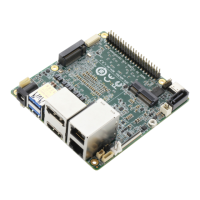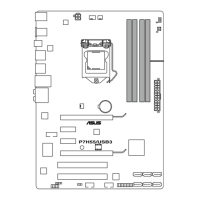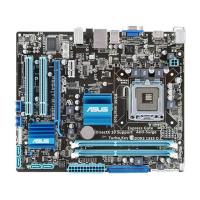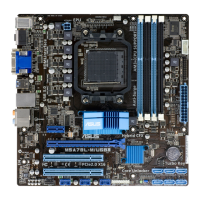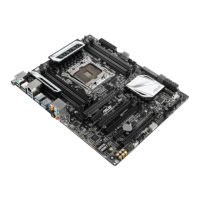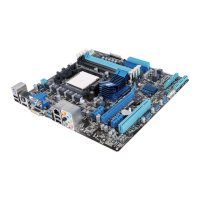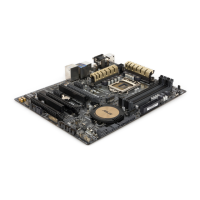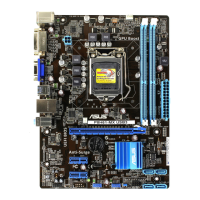
Do you have a question about the Asus UP-895MD Series and is the answer not in the manual?
| Brand | Asus |
|---|---|
| Model | UP-895MD Series |
| Category | Motherboard |
| Language | English |
Precautions to prevent electrical shock hazards and ensure safe operation.
Guidelines for safe handling and operation of the motherboard and components.
Outlines the structure and chapters of the user guide for clarity.
Points to additional resources like the ASUS website for updates.
Explains text formatting conventions like bold, italics, and key notations.
Details the key features and technological highlights of the motherboard.
Describes additional special features and functionalities of the motherboard.
Provides an overview of the motherboard layout and key components.
Illustrates and details the physical layout of the motherboard components and connectors.
Explains the CPU socket type and installation precautions for the motherboard.
Details the DDR3 DIMM slots and memory installation guidelines.
Describes the PCIe slots available for expansion cards and their configurations.
Details the function of onboard buttons like Power-on and EZ XMP switches.
Explains the function and usage of onboard jumpers like Clear RTC RAM.
Describes the purpose and location of various onboard LEDs for system status indication.
Details the internal connectors on the motherboard for various devices and peripherals.
Guides on assembling the PC system and installing components onto the motherboard.
Provides step-by-step instructions for safely installing the CPU into the socket.
Details the process of installing the CPU heatsink and fan for proper cooling.
Explains how to install memory modules (DIMMs) into the motherboard slots.
Guides on connecting the ATX power supply to the motherboard for system power.
Illustrates how to connect SATA hard disk drives and other storage devices.
Explains the connection of front panel connectors for power, reset, LEDs, and audio.
Details the installation procedure for expansion cards like PCIe x16 and x1.
Guides on connecting the Wi-Fi antennas to the motherboard.
Explains how to update the BIOS using utilities like USB BIOS Flashback.
Details the rear panel connectors for various I/O devices and audio.
Provides instructions for the initial power-on and system boot process.
Explains the proper procedures for shutting down or putting the computer into sleep mode.
Introduces the UEFI BIOS interface and its role in system configuration.
Guides on entering and navigating the BIOS setup utility, including modes and hotkeys.
Explains the simplified EZ Mode interface for basic system information and settings.
Details the Advanced Mode interface for comprehensive BIOS configuration options.
Allows configuration of CPU and chassis fan profiles for optimal cooling and noise levels.
Guides through automatic system tuning for CPU, DRAM, and RAID setup.
Personal space to save and access frequently used BIOS settings and configurations.
Provides an overview of system information and allows setting date, time, language, and security.
Allows configuration of overclocking-related items for performance tuning.
Offers advanced settings for CPU and other system devices, requiring caution.
Displays CPU-related information and allows configuration of CPU features.
Allows configuration of PCI Express slots and related technologies.
Configures SATA devices, SATA Express, and M.2 slots.
Manages settings for CPU display audio, DVI port audio, and graphics configuration.
Allows configuration of USB-related features like legacy support and xHCI mode.
Configures platform-specific features like HD Audio, Bluetooth, Wi-Fi, and storage controllers.
Manages onboard device settings like HD Audio, Bluetooth, Wi-Fi, and USB controllers.
Configures power management settings like ErP Ready and AC power loss behavior.
Enables or disables UEFI network stack and PXE support for network booting.
Manages RAID volume creation and configuration using Intel RST.
Displays system temperatures, voltages, fan speeds, and allows fan control.
Configures boot order, fast boot, boot logo, and other boot-related settings.
Provides access to special function utilities like EZ Flash and OC Profile.
Allows loading default settings, saving or discarding changes, and exiting the BIOS setup.
Instructions and utilities for updating the motherboard BIOS for stability and performance.
Notes on supported operating systems and general setup procedure references.
Details the contents and usage of the motherboard support DVD.
Guides on how to launch the support DVD's main menu and install software.
Explains how to access software manuals in PDF format from the support DVD.
Overview of applications on the support DVD and accessing online help.
Introduction to AI Suite 3, an integrated ASUS utility package for system management.
Utility for fast-charging portable mobile devices via USB ports.
Enhances USB 3.0 transfer speeds using UASP and Turbo Mode.
Utility for updating motherboard drivers, software, and BIOS easily.
Allows checking and saving the latest BIOS version to a USB storage device.
Enables quick-charging of portable USB devices even when the computer is off or in sleep mode.
Sends system status alerts and messages to a smart device.
Displays detailed motherboard, CPU, and memory information.
Details the Realtek audio CODEC features and driver installation.
Explains Intel Rapid Storage Technology and RAID levels (0, 1, 5, 10).
Guides on installing SATA hard disks for optimal RAID performance.
Instructions on enabling RAID mode in BIOS setup before creating RAID sets.
Details on accessing and using the Intel RST Option ROM utility for RAID management.
Explains how to create a USB driver disk for RAID installation in Windows.
Contains regulatory compliance statements from FCC, IC, VCCI, KC, and REACH.
Provides contact details for ASUS technical support globally.
